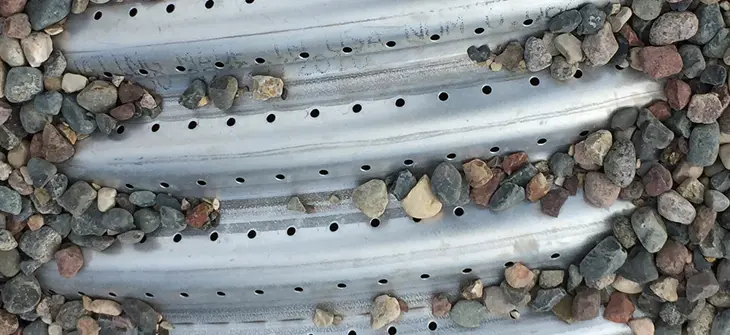
Three Components of Infiltration System Design
Three Components of Infiltration System Design
Common infiltration practices include drywells, bioretention, permeable pavement, infiltration trenches, infiltration basins, and subsurface infiltration galleries. Regardless of their form, all infiltration systems have three primary components: storage, treatment, and infiltration.
1. Storage
Retention volume of a BMP is when runoff accumulates during a storm and is stored prior to infiltration or treatment. In a landscape-based system, storage tends to be the most upstream component in the form of depressional storage.
For example, a bioretention cell may store 6 to 12 inches of water in a surface pool that slowly infiltrates at a rate dictated by the native soils. One method of increasing storage in a landscape-based system is to add highly permeable, high-void soil amendments.
In subsurface systems, the storage component is often located between the treatment and infiltration components. For example, runoff may be routed to a hydrodynamic separator or cartridge-based media filter, then to a network of large-diameter perforated pipe from which it percolates into the surrounding native soil. In subsurface systems, storage may be comprised entirely of gravel, but many high-voids options are available to minimize the overall volume of the system. For example, perforated pipes, concrete arches and vaults, and plastic chambers are all commonly used.
2. Treatment
The treatment component should be tailored to expected pollutants onsite, the vulnerability of the downstream waters to those pollutants, and the infiltrating surface's susceptibility to clogging.
In a landscape-based system, the treatment component is typically comprised of plants and soil. For example, in a bioretention system, most pollutants are removed and retained in the mulch and upper layer of soil. Landscape-based water quality BMPs such as swales or biofiltration may be used as treatment upstream of subsurface systems, but subsurface treatment is more commonly provided in the form of a hydrodynamic separator or media filter.
Adequate treatment is a crucial component of all infiltration systems. Inadequate treatment will allow pollutants to migrate to the native soils where clogging of interstitial pore space can quickly reduce infiltration rates. In landscape-based BMPs, failure of the mulch and/or top soil layer to infiltrate due to sediment accumulation can lead to frequent bypass or flooding even when the native soils have ample capacity.
Ideally, treatment is provided in the form of filtration through engineered soil or filter media that will remove particles in the 5- to 10-micron range and larger. Sometimes, this is not practical due to site constraints or budgetary limitations. A good second option is gravity separation. There are several commercially available hydrodynamic separators that can reliably remove particles as fine as 50 microns without requiring the large footprint and long detention times of traditional plug flow clarifiers or baffle boxes. For those with severe budgetary limitations, catch basin inserts can provide some pretreatment benefits as long as utmost attention to operation and maintenance can be assured.
3. Infiltration
The native soil infiltration rate often drives decisions about the size and form of the infiltration system. The lower infiltration rates are, the shallower and broader the system must become. There are a range of methods for determining infiltration rates, from local soil maps to detailed soil testing. The actual infiltration rate is usually converted to a design infiltration rate by applying a safety factor that accounts for uncertainty in the known rate, assumed reduction in performance over time, treatment effectiveness, and other factors. Safety factors commonly range from 2-10. With a factor of safety of two, the allowable system height would be halved. The design infiltration rate is then used to establish system dimensions and size.
Great care must be taken to ensure that the interface between the storage or treatment component and the native soils is not fouled either by materials passing through the treatment system. In systems where gravel or high-void subsurface structures such as perforated pipes or chambers are used, it is also critical that native soils are prevented from migrating into the storage component. If this happens, subsidence of soils at the surface may occur. The barrier between subsurface storage gravel or galleries and native soils is most often a nonwoven geotextile. During construction, compaction of native soils must be avoided to ensure that optimal infiltration rates are preserved.
